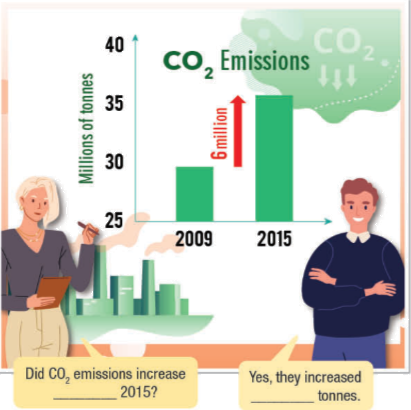Đừng bỏ lỡ những tính năng hấp dẫn của Baitap365.com
Let's Talk! In pairs: Which environmental problem does this picture show? What are some things humans do to cause this environmental problem? New Words a. Match the underlined words to the definitions. Listen and repeat. b. In pairs: Use the new words to talk about environmental problems in your country. Listening a. Listen to two students talking about global warming. What is their project about? b. Now, listen and complete the table.
Let's Talk!
In pairs: Which environmental problem does this picture show? What are some things humans do to cause this environmental problem?
(Theo cặp: Bức tranh này thể hiện vấn đề môi trường nào? Một số điều con người làm để gây ra vấn đề môi trường này là gì?)

New Words - a
a. Match the underlined words to the definitions. Listen and repeat.
(Nối các từ được gạch chân với các định nghĩa. Lắng nghe và lặp lại.)
|
1. Fossil fuels are one of the main ways we get electricity. 2. Global warming has caused the Earth to get hotter. 3. The forest is getting smaller by fifty thousand hectares a day. 4. Billions of tonnes of plastics are released into the ocean every year. 5. The air quality in the city is really bad because of the emissions from traffic and factories. 6. Approximately 2,400 trees are cut down. every minute. 7. Carbon dioxide in the atmosphere has reached dangerously high levels. |
a. a unit of weight-one of these is the same as one thousand kilograms. b. types of energy like gas, oil, and coal c. an area which is the same as ten thousand square meters d. the increase in Earth's temperature because of more greenhouse gases in the air e. gas (also known as CD) which comes from humans, animals, and burning trees and coal. f. gas or smoke which goes into the air and damages the environment g. near or close to a number or amount |
New Words - b
b. In pairs: Use the new words to talk about environmental problems in your country.
(Theo cặp: Sử dụng các từ mới để nói về các vấn đề môi trường ở đất nước của bạn.)
We have a lot of emissions from factories in our country.
(Chúng ta có rất nhiều khí thải từ các nhà máy ở nước ta.)
Listening - a
a. Listen to two students talking about global warming. What is their project about?
(Nghe hai sinh viên nói về sự nóng lên toàn cầu. Dự án của họ là về cái gì?)
1. the causes of global warming
(nguyên nhân của sự nóng lên toàn cầu)
2. the effects of global warming
(tác động của sự nóng lên toàn cầu)
Listening - b
b. Now, listen and complete the table.
(Bây giờ, lắng nghe và hoàn thành bảng.)
|
South Korea CO2 emissions (millions of tonnes) |
|
|
1971 |
(1) _______________ |
|
(2) _______________ |
480 |
|
2016 |
600 |
|
Global deforestation (millions of hectares) |
|
|
(3) _______________ |
3 |
|
2016 |
(4) _______________ |
|
2020 |
(5) _______________ |
Listening - c
c. Read the Conversation Skill box. Then, listen and repeat.
(Đọc hộp Kỹ năng đàm thoại. Sau đó, nghe và lặp lại.)
|
Conversation Skill: (Kỹ năng đàm thoại) Asking for repetition (Yêu cầu lặp lại) We can ask the other speaker to repeat something by saying: (Chúng ta có thể yêu cầu người khác lặp lại điều gì đó bằng cách nói) Sorry, how much? (Xin lỗi, bao nhiêu?) (Sorry,) Can you say that again? ((Xin lỗi,) Bạn có thể nói lại lần nữa không?) |
Listening - d
d. Now, listen to the conversation again and circle the phrase you hear.
(Bây giờ, hãy nghe lại đoạn hội thoại và khoanh tròn cụm từ mà bạn nghe được.)
Listening - e
e. In pairs: Do you think Pete and Jane were surprised by what they found out? Why (not)?
(Theo cặp: Bạn có nghĩ rằng Pete và Jane đã ngạc nhiên trước những gì họ phát hiện ra không? Tại sao không)?)
Grammar Meaning & Use - a
a. Look at the picture. What do you think the people are saying?
(Nhìn vào bức tranh. Bạn nghĩ mọi người đang nói gì?)

Grammar Meaning & Use - b
b. Now, listen and check your ideas.
(Bây giờ, hãy lắng nghe và kiểm tra ý tưởng của bạn.)
Grammar Meaning & Use - c
c. Listen and repeat.
(Lắng nghe và lặp lại.)
Did CO2 emissions increase from 2019 to 2015?
(Lượng khí thải CO2 có tăng từ năm 2019 đến năm 2015 không?)
Yes, they increased by six million tonnes.
(Đúng vậy, chúng đã tăng thêm sáu triệu tấn.)
Grammar Form & Practice - a
a. Fill in the blanks using from... to... or by.
(Điền vào chỗ trống sử dụng from... to... hoặc by.)
1. From 1995 to 1997, one hundred thousand trees were cut down.
2. Traffic emissions in Jakarta increased __________ 10%.
3. Did emissions rise __________ 2010 ____________ 2020?
4. Deforestation increased __________ one hundred thousand hectares from 2008 to 2010.
5. The number of cars on our streets increased __________ five million ___________ six million in 1998.
Grammar Form & Practice - b
b. Answer the questions using the table.
(Trả lời các câu hỏi bằng cách sử dụng bảng.)
|
Deforestation in Brazil (Nạn phá rừng ở Brazil) |
|||
|
Years (Các năm) |
Area (millions of hectares) (Diện tích (triệu ha)) |
Change (millions of hectares) (Thay đổi (triệu ha)) |
|
|
2001 – 2005 |
3 – 3.4 |
+0.4 |
|
|
2006 – 2010 |
2.9 – 2. 7 |
-0.2 |
|
|
2011 – 2016 |
1.9 – 5.4 |
+ 3.5 |
|
|
2017 - 2020 |
4.5 – 3.3 |
-1.2 |
|
1. How did the area of deforestation change from 2001 to 2005?
It increased from 3 to 3.4 million hectares.
2. How much did deforestation decrease from 2006 to 2010?
_________________________________________________
3. How did the area of deforestation change from 2011 to 2016?
_________________________________________________
4. How did the area of deforestation change from 2017 to 2020?
_________________________________________________
5. How much did deforestation decrease from 2017 to 2020?
_________________________________________________
Grammar Form & Practice - c
c. In pairs: Ask and answer using the information in the table.
(Theo cặp: Hỏi và trả lời bằng cách sử dụng thông tin trong bảng.)
Did deforestation increase from 2001 to 2005?
(Phá rừng có tăng từ năm 2001 đến 2005 không?)
Yes, it went up by zero point four million hectares.
(Đúng vậy, nó đã tăng lên 0,4 triệu ha.)
Pronunciation - a
a. Stress the first syllable for large numbers.
(Nhấn âm tiết đầu tiên cho số lượng lớn.)
Pronunciation - b
b. Listen to the words and focus on the underlined letters.
(Nghe các từ và tập trung vào các chữ cái được gạch chân.)
hundred (trăm)
thousand (nghìn)
million (triệu)
Pronunciation - c
c. Listen and cross out the word with the wrong word stress.
(Nghe và gạch bỏ từ có trọng âm sai.)
thousand (ngìn)
trillion (tỷ tỷ)
billion (tỷ)
Pronunciation - d
d. Read the words with the correct stress to a partner.
(Đọc các từ với trọng âm chính xác cho bạn cùng nghe.)
Practice
Point, ask, and answer.
(Chỉ, hỏi và trả lời.)
Did CO2 emissions increase from 2016 to 2017?
(Lượng khí thải CO2 có tăng từ năm 2016 đến năm 2017 phải không?)
Yes. They increase from two hundred thousand to approximately three hundred thousand tonnes.
(Đúng. Chúng tăng từ hai trăm nghìn lên xấp xỉ ba trăm nghìn tấn.)
Did deforestation increase from 2019 to 2020?
(Phá rừng có tăng từ 2019 đến 2020 phải không?)
Yes. It rose by approximately one hundred thousand hectares.
(Đúng. Nó đã tăng khoảng một trăm nghìn ha.)
|
|
2016 |
2017 |
2018 |
2019 |
2020 |
|
CO2 emissions (tonnes) (Lượng khí thải CO2 (tấn)) |
200,000 |
300,000 + 100,000 |
350,000 + 50,000 |
380,000 + 30,000 |
500,000 + 120,000 |
|
Deforestation (hectares) (Phá rừng (hecta)) |
550,000 |
500,000 - 50,000 |
620,000 + 12,00 |
590,000 - 30,000 |
700,000 + 110,000 |
Speaking - a
GLOBAL WARMING IN WESTLAND
(HIỆN TƯỢNG NÓNG LÊN TOÀN CẦU Ở MIỀN TÂY)
a. You're a scientist studying global warming. In pairs: Student B turn to page 114 File 5. Student A, ask about deforestation in Westland and complete the chart.
(Bạn là một nhà khoa học nghiên cứu về sự nóng lên toàn cầu. Theo cặp: Học sinh B chuyển đến trang 114 File 5. Học sinh A, hỏi về nạn phá rừng ở Westland và hoàn thành biểu đồ.)
Did deforestation increase from 2013 to 2014?
(Phá rừng có tăng từ 2013 đến 2014 không?)
No. It fell by approximately four hundred thousand hectares.
(Không. Nó đã giảm khoảng bốn trăm nghìn ha.)
So it went down from seven hundred thousand to about three hundred thousand?
(Vì vậy, nó đã giảm từ bảy trăm nghìn xuống còn khoảng ba trăm nghìn?)
That's right.
(Đúng rồi.)

Speaking - b
b. Swap roles and repeat. Answer questions about CO2 emissions in Westland.
(Đổi vai và lặp lại. Trả lời các câu hỏi về CO2, khí thải ở Westland.)

Speaking - c
c. Do you think deforestation or CO2 emissions are the bigger problem for Westland? Why?
(Bạn có nghĩ rằng nạn phá rừng hoặc CO2 là vấn đề lớn hơn đối với Westland? Tại sao?)
Mẹo tìm đáp án nhanh
Search Google: "từ khóa + baitap365" Ví dụ: "Bài 5 trang 13 SGK Vật lí 12 baitap365